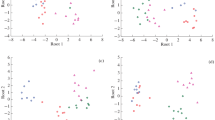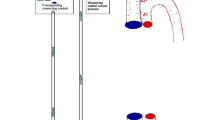Abstract
The alteration of monoamines and their metabolites in the brain during and after hemorrhagic shock in the conscious state was measured in rats. Blood pressure was maintained at 40–70 mmHg (5.3–9.3 kPa) for 60 min by withdrawing 8 ml of blood intermittently. The content of monoamines, as well as their metabolites, increased in various brain regions during hemorrhage, compared with the content in the control rats. Sixty min after the end of the bleeding period, almost no significant change in the contents of brain monoamines nor of their metabolites was observed. These results may indicate not only an increased release of monoamines from nerve terminals, but also an increased synthesis of them during hemorrhagic shock. Soon after the bleeding was stopped, the increased monoamine turnover rate returned to almost normal levels.
Similar content being viewed by others
References
Scriabine A, Clineschmidt BV, Sweet CS: Central noradrenergic control of blood pressure. Ann Rev Pharmacol Toxicol 16:113–123, 1976
Robinson SE: Serotonergic-cholinergic interactions in blood pressure in the rat. Fed Proc 43:21–24, 1984
Brezenoff HE: Cardiovascular regulation by brain acetylcholine. Fed Proc 43:17–20, 1984
Gillis RA, Yamada KA, Dimicco JA, Williford DJ, Segal SA, Hamosh P, Norman WP: Central γ-aminobutyric acid involvement in blood pressure control. Fed Proc 43:32–38, 1984
Talman WT, Granata AR, Reis DJ: Glutaminergic mechanisms in the nucleus tractus solitarius in blood pressure control. Fed Proc 43:39–44, 1984
Holaday JW: Cardiovascular consequences of endogenous opiate antagonism. Biochem Pharmacol 32:573–585, 1983
Feuerstein G, Helke C, Faden AI: Differential changes in substance P and somatostatin in brain nuclei of rats exposed to hemorrhagic shock. Brain Res 300:305–310, 1984
Okuda C, Mizobe T, Miyazaki M: The involvement of central cholinergic mechanisms in cardiovascular responses to intracerebroventricular and intravenous administration of thyrotropin-releasing hormone. Life Sci 40:1293–1299, 1987
Conlay LA, Maher TJ, Godley BF, Wurtman RJ: Spinal cord noradrenergic neurons are activated in hypotension. Brain Res 375:210–213, 1986
Mizobe T, Okuda C: Changes in brain thyrotropin-releasing hormone in reversible and irreversible hemorrhagic shock in the rat. Circulatory shock 26:245–256, 1988
Keller HH, Bartholini G, Pletsher A: Enhancement of cerebral noradrenaline turnover by thyrotropin-releasing hormone. Nature 248:528–529, 1974
Morley JE: Extrahypothalamic thyrotropin releasing hormone (TRH)-its distribution and its functions. Life Sci 25:1539–1550, 1979
Engber TM, Manaker S, Kreider MS, Winokur A: Intraventricular 6-hydroxydopamine increases thyrotropin-releasing hormone (TRH) content in regions of rat brain. Regulatory Peptides 12:51–57, 1985
Marbach EP, Weil MH: Rapid enzymatic measurement of blood lactate and pyruvate: Use and significance of metaphosphoric acid as a common precipitant. Clin Chern 13:314–325, 1967
Valley H: Practical Clinical Biochemistry, W. Heinmann Medical Books, Ltd, New York, 1967,pp. 618
Glowinski J, Iversen LL: Regional studies of catecholamines in the rat brain1. The disposition of [3H]norepinephrine, [3H]dopamine and [3H]DOPA in various regions of the brain. J Neurochem 13:655–669, 1966
Wagner J, Vitali P, Palfreyman MG, Zraika M, Huot S: Simultaneous determination of 3,4-dihydroxyphenylalanine, 5hydroxytryptophan, dopamine, 4-hydroxy-3methoxyphenylalanine, norepinephrine, 3,4dihydroxyphenylacetic acid, homovanillic acid, serotonin and 5-hydroxyindoleacetic acid in rat cerebrospinal fluid and brain by high-performance liquid chromatography with electrochemical detection. J Neurochem 38:1241–1254, 1982
Smythe GA, Grunstein HS, Bradshaw JE, Nicholson MV, Compton PJ: Relationships between brain noradrenergic activity and blood glucose. Nature 308:65–67, 1984
Preston KL, Wagner GC, Schuster CR, Seiden LS: Long-term effects of repeated methylamphetamine administration on monoamine neurons in the rhesus monkey brain. Brain Res 338:243–248, 1985
Kalivas PW: Sensitization to repeated enkephalin administration into the ventral tegmental area of the rat. 11. Involvement of the mesolimbic dopamine system. J Pharmacol Exp Ther 235:544–550, 1985
Coleman B, Glaviano VV: Tissue levels of norepinephrine and epinephrine in hemorrhagic shock. Science 139:54, 1963
Wijnen HJLM, De Kloet ER, Versteeg DHG, De Jong W: Differences in regional brain catecholamine metabolism after a decrease in blood pressure. Life Sci 23:2587–2592, 1978
Szymanska-Kosmala M, Filczewski M: Tissue catecholamine concentrations in the brain, heart and adrenals in experimental hypovolaemia in rats. Acta Physiol Pol 31:159–166, 1980
Sinha IN, Dielt H, Philippu A: Effect of a fall of blood pressure on the release of catecholamines in the hypothalamus. Life Sci 26:1751–1760, 1980
Yokote H, Itakura T, Nakai K, Kamei I, Imai H, Komai N: A role of the central catecholamine neuron in cerebral circulation. J Neurosurg 65:370–375, 1986
Author information
Authors and Affiliations
About this article
Cite this article
Mizobe, T., Okuda, C., Demura, H. et al. Changes in brain monoamines and their metabolites during and after hemorrhagic shock in the rat. J Anesth 4, 116–122 (1990). https://doi.org/10.1007/s0054000040116
Received:
Accepted:
Issue Date:
DOI: https://doi.org/10.1007/s0054000040116




